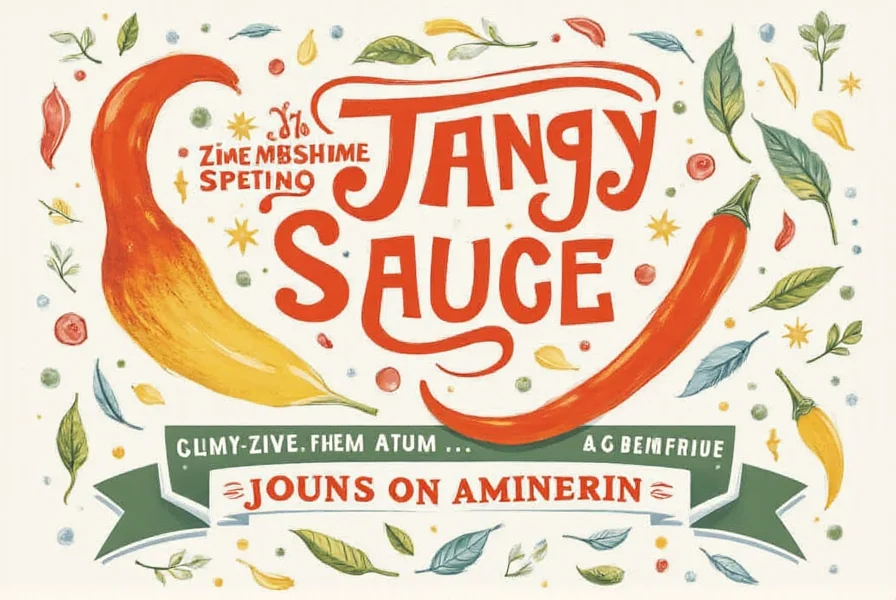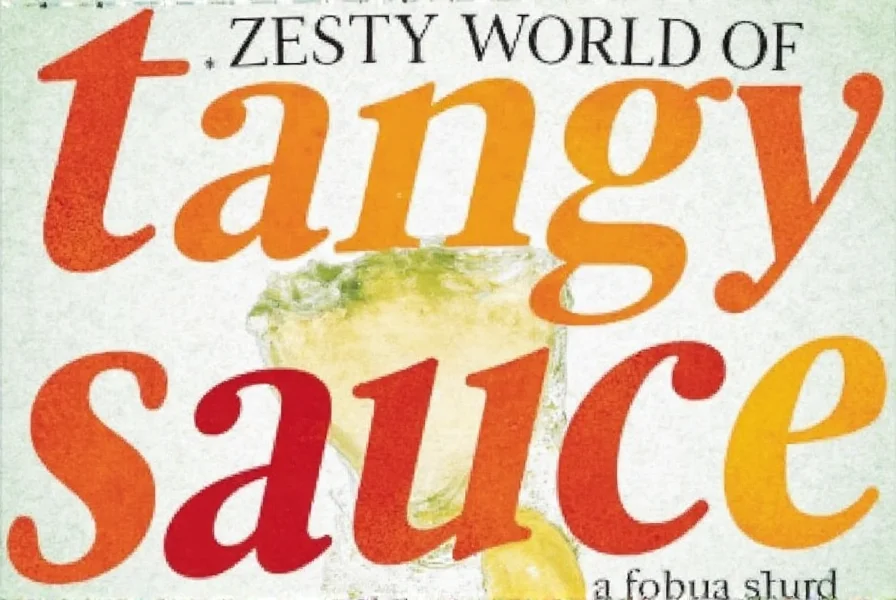Table of Contents
Introduction to Tangy Sauce
Tangy sauce is a versatile condiment with a bright, acidic flavor that enhances a wide range of dishes. Made from ingredients like vinegar, citrus juice, and sweeteners, it balances richness and adds a refreshing kick. Whether you're cooking grilled chicken, seafood, or vegetables, tangy sauce can transform your meal. In this guide, we'll cover everything you need to know, from types and recipes to expert usage tips.
Understanding the Flavor Profile
Tangy sauce isn't just about acidity—it's about balance. While the main component is usually something sour like lemon juice or vinegar, it's often paired with sweetness, saltiness, or even heat to create a well-rounded flavor profile.
Here's a quick breakdown of what makes a tangy sauce stand out:
- Sourness: This is the backbone of tangy sauce, typically from citrus fruits, apple cider vinegar, or white wine vinegar.
- Sweetness: A touch of sugar or honey can help mellow out the sharpness and add depth.
- Salt: Salt enhances the overall flavor and helps bring out the other elements.
- Heat: Some tangy sauces include chili or hot sauce to add a spicy kick.
- Herbs and Spices: Fresh herbs like cilantro or dill, or spices like ginger or garlic, can elevate the flavor even further.
Professional chefs recommend a 3:2:1 ratio of acid:sweet:salt for balanced tangy sauce. The goal is to enhance the dish, not mask it. A little goes a long way, so start with small amounts and adjust as needed.
Types of Tangy Sauces Around the World
| Country/Cuisine | Popular Tangy Sauce | Description |
|---|---|---|
| Chinese | Soy-Ginger Vinaigrette | A blend of soy sauce, rice vinegar, ginger, and sesame oil. Mix 2 tbsp soy sauce, 1 tbsp rice vinegar, 1 tsp ginger, and 1 tsp sesame oil for an authentic stir-fry enhancer. |
| Mexican | Guacamole Lime Sauce | Avocado mixed with lime juice, garlic, and chili. Perfect for tacos and nachos; blend 1 ripe avocado, 2 tbsp lime juice, 1 clove garlic, and 1 tsp chili powder. |
| Indian | Chutney | Usually made with tamarind, mint, and green chilies. Adds a punch to snacks; simmer 1 cup tamarind pulp, 1/4 cup sugar, and 2 green chilies for 10 minutes. |
| Italian | Aceto Balsamico Glaze | A sweet and tangy reduction of balsamic vinegar. Ideal for drizzling over meats and cheeses; reduce 1 cup balsamic vinegar by half over low heat. |
| Japanese | Katsu Sauce | A thick, tangy sauce made with ketchup, Worcestershire sauce, and vinegar. Often served with tonkatsu; combine 1/4 cup ketchup, 2 tbsp Worcestershire, 1 tbsp vinegar, and 1 tsp sugar. |
Each of these sauces has its own distinct character, but they all share that signature tangy bite that makes them so appealing. Experimenting with different types can open up a whole new world of flavor possibilities.
Essential Cooking Tips for Using Tangy Sauce
If you're new to using tangy sauce, here are some tips to help you get the most out of it:
- Start Small: Because tangy sauce can be quite strong, begin with a small amount and adjust to taste.
- Balance the Flavors: If your sauce is too sour, add a bit of honey or sugar. If it's too sweet, a splash of vinegar or citrus juice can help.
- Use Fresh Ingredients: Freshly squeezed juice or homemade vinegar will give your sauce a more vibrant flavor.
- Pair Smartly: Tangy sauce pairs well with grilled meats, seafood, vegetables, and even desserts like fruit tarts.
- Store Properly: Keep your homemade tangy sauce in an airtight container in the refrigerator for up to a week.
One of the best ways to use tangy sauce is as a marinade. It helps tenderize proteins while adding a burst of flavor. Try this Easy Homemade Tangy Sauce Recipe for chicken: Combine 1/4 cup apple cider vinegar, 2 tbsp honey, 1 tbsp lemon juice, 1 tsp soy sauce, and a pinch of black pepper. Marinate for 2-4 hours before grilling for tender, flavorful results.
Buying Guide for the Best Tangy Sauces
If you're looking to buy tangy sauce, there are several factors to consider, including quality, flavor, and versatility. Here's a detailed guide to help you choose the right one:
1. Apple Cider Vinegar Tangy Sauce
Features: Made with apple cider vinegar, this sauce offers a slightly sweet and tart flavor.
Advantages: Versatile for both savory and sweet dishes, it adds a nice depth of flavor.
Use Cases: Ideal for salad dressings, marinades, and dipping sauces.
Target Audience: Home cooks who enjoy experimenting with natural ingredients.
Suitable Occasions: Casual dinners, potlucks, and outdoor barbecues.
2. Lemon-Garlic Tangy Sauce
Features: A bright and zesty sauce made with fresh lemon juice and garlic.
Advantages: Offers a clean, refreshing taste that works well with seafood and vegetables.
Use Cases: Perfect for drizzling over grilled fish or mixing into pasta dishes.
Target Audience: Health-conscious individuals and those who prefer lighter flavors.
Suitable Occasions: Light lunches, summer gatherings, and gourmet meals.
3. Tomato-Based Tangy Sauce
Features: Combines tomatoes with a tangy twist, often incorporating vinegar or citrus.
Advantages: Adds a juicy, flavorful element to burgers, sandwiches, and wraps.
Use Cases: Great for sandwich toppings, pizza bases, and dip applications.
Target Audience: People who enjoy bold, tomato-forward flavors.
Suitable Occasions: Family dinners, picnics, and casual dining.

4. Ketchup-Vinegar Blend
Features: A fusion of ketchup and vinegar for a sweet and tangy flavor.
Advantages: Offers a familiar yet dynamic taste that pairs well with many foods.
Use Cases: Excellent for dipping fries, burgers, and grilled meats.
Target Audience: Those who love classic American flavors with a twist.
Suitable Occasions: Barbecues, sporting events, and family meals.

5. Homemade Tangy Sauce Kit
Features: Includes all the necessary ingredients to make your own tangy sauce at home.
Advantages: Allows for customization and creativity in flavor combinations.
Use Cases: Perfect for DIY enthusiasts and those who enjoy making their own condiments.
Target Audience: Foodies and people who like to experiment in the kitchen.
Suitable Occasions: Gift-giving, cooking classes, and personal culinary projects.
When choosing a tangy sauce, always read the label to ensure it aligns with your dietary preferences. Look for options with minimal additives and natural ingredients for the best results.
Frequently Asked Questions
What exactly makes a sauce "tangy"?
A sauce is considered "tangy" when it has a pronounced sour or acidic quality that's balanced with other flavor elements. This tanginess typically comes from ingredients like citrus juices (lemon, lime), various vinegars (apple cider, rice, white wine), or naturally tart fruits. The key is that the sourness is bright and refreshing rather than overwhelming, creating that characteristic zing that makes your mouth water.
How can I make my tangy sauce less sour if I've added too much acid?
If your tangy sauce has become too sour, there are several ways to balance it. The most effective method is to add sweetness - a small amount of honey, sugar, or maple syrup can counteract excessive sourness. You can also dilute the sauce with a neutral liquid like water or broth, or add creamy elements like yogurt or mayonnaise to mellow the acidity. Remember to adjust gradually and taste as you go, as it's easier to add more acid than to remove it once added.
What's the difference between tangy sauce and regular sauce?
The primary difference is the intentional emphasis on sour or acidic notes in tangy sauce. While regular sauces might focus on richness, creaminess, or umami, tangy sauces deliberately highlight that bright, acidic quality. Tangy sauces are specifically designed to cut through rich flavors and refresh the palate, whereas many regular sauces aim to complement or enhance existing flavors without that pronounced sour element. Tangy sauces often serve as balancing agents in dishes that might otherwise be heavy or one-dimensional.
Can I use tangy sauce as a marinade for meats?
Absolutely! Tangy sauces make excellent marinades because the acidity helps break down proteins, tenderizing the meat while infusing it with flavor. The acid in tangy sauces works similarly to buttermilk or yogurt marinades, but with a brighter flavor profile. For best results, marinate meats for 2-4 hours (or up to 24 hours for tougher cuts), but avoid over-marinating as excessive acid can make the surface of the meat mushy. Always marinate in the refrigerator, not at room temperature.
How long does homemade tangy sauce last in the refrigerator?
Most homemade tangy sauces will keep for 7-10 days when stored in an airtight container in the refrigerator. Sauces with higher acid content (like those made primarily with vinegar) may last closer to 2 weeks, while those containing fresh citrus juice or dairy elements will be at the shorter end of that range. Always check for signs of spoilage before using - if the sauce develops an off smell, mold, or unusual texture, it should be discarded. For longer storage, consider freezing small portions in ice cube trays.
What are common mistakes when making tangy sauce?
Common mistakes include using stale ingredients (which dull the flavor), skipping the balance step (too much acid or sweetness), and not adjusting for the dish type. For example, a sauce for seafood should be lighter than one for grilled meats. Always taste as you go and start with small quantities of acid to avoid overpowering the dish.
How can I adjust tangy sauce for different cuisines?
For Asian dishes, use rice vinegar and soy sauce for authenticity. Mexican cuisine benefits from lime juice and chili peppers. Italian recipes pair well with balsamic reduction. Indian curries need tamarind-based chutneys. Always consider the dish's dominant flavors - tangy sauce should complement, not compete with them.
Conclusion
Tangy sauce is more than just a condiment—it's a flavor enhancer that can elevate any dish. From its zesty acidity to its ability to complement a wide range of foods, it's a must-have in every spice lover's kitchen.
Whether you're cooking at home or dining out, understanding how to use and appreciate tangy sauce can take your culinary experience to the next level. Try this expert-approved recipe today and discover your favorite tangy sauce combination!










 浙公网安备
33010002000092号
浙公网安备
33010002000092号 浙B2-20120091-4
浙B2-20120091-4